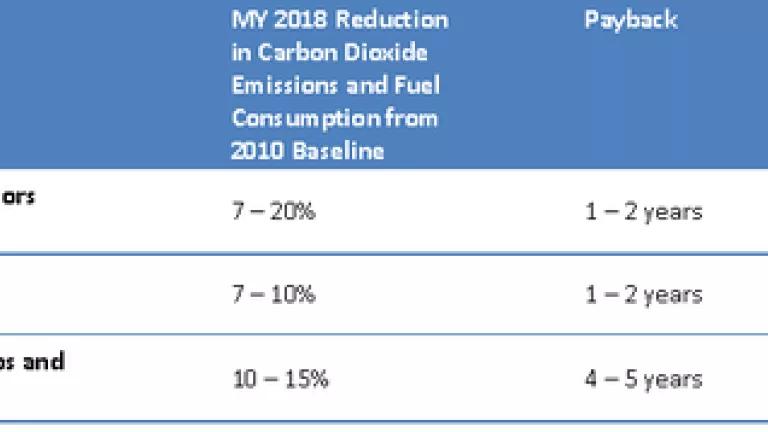Obama Finalizing First-ever Efficiency and Carbon Pollution Standards for Heavy Trucks, Saving Money and Boosting Jobs

Tomorrow, President Obama will announce new fuel efficiency and carbon pollution standards for heavy-duty trucks. This is a historic step forward because these are first-ever standards of this type and they start the of process of what are expected to be ongoing improvements in heavy truck performance. The standards will result in freight moving farther on a gallon of fuel and trucks that are cleaner, adding less carbon pollution to the atmosphere.
The Tuesday announcement marks the finalization of rules that were initiated in May 2010 to cover model years 2014 to 2018. By 2030, the standards are expected to cut annual emissions by over 50 million metric tons of carbon dioxide and save over 300,000 barrels of oil per day. The truck standards are the third of a series of vehicle efficiency and carbon pollution improvements that also includes two sets of standards for cars and light trucks that will reach 35.5 mpg in 2016 and 54.5 mpg in 2025. Collectively, the car and truck standards comprise the National Program for vehicle efficiency and are a giant step toward reaching President Obama’s goal of cutting oil imports by one-third by 2025 and for reducing heat-trapping greenhouse gas emissions.
The trucks covered by the Heavy Duty National Program include the tractors of combination tractor-trailers (“18-wheelers”), city buses, garbage haulers, delivery vehicles and work trucks over 8,500 lbs. These trucks consume about 20 percent of the oil used in the transportation sector and emit about 20 percent of transportation sector carbon pollution yet trucks represent only 4 percent of the vehicles on the roads. They are truly the energy hogs of American highways but they will become more efficient in the near future.
Improvements to lower emissions and fuel consumption will come from more sophisticated combustion engine systems and controls, aerodynamic adjustments, fuel-efficient tires, and fuel-sipping auxiliary power units for idling, all of which are off-the-shelf technologies.
According to the standards as proposed jointly by the Environmental Protection Agency and National Highway Traffic Safety Administration last October, trucks will cut carbon dioxide pollution and fuel consumption by 7 to 20 percent, as shown in the table below. We expect the final rules released tomorrow will have the same stringencies and achieve at least the same level of benefits. Note that the savings below were calculated by the federal agencies using a fuel price forecast that assumes diesel at less $3.00 per gallon at the pump today and $3.41 in 2018. Diesel prices, however, are already much higher--averaging about $3.90/gal for the last month—making the payback for more fuel-efficient technologies even faster than projected in the proposal.
Data from EPA, NHTSA Notice of Proposed Rulemaking, 75 Federal Register at 74152, available at http://www.epa.gov/otaq/climate/regulations.htm#1-2.
A new long-haul tractor-trailer typically averages over 100,000 miles per year and consumes at least 15,000 gallons of fuel per year. At $3.50/gallon, a 20 percent reduction in fuel consumption as a result of the standards would save $10,700 in expenditures at the pump in one year. Similarly, a heavy-duty pickup truck averaging 14 miles per gallon and traveling 13,000 miles per year will see annual fuel savings of $325 with just a 10 percent drop in consumption.
Diesel fuel prices are about a dollar more than a year ago and stronger standards couldn’t come at a more important time. By making trucks more efficient, the standards give the truckers and the businesses that depend on them the tools they need to save on fuel.
We all depend on trucks to deliver the goods we consume. Making trucks more fuel efficient means the delivery costs of goods is less influenced by volatile world oil prices, which is good for consumers as well as businesses.
The standards are good for truck engine and vehicle manufacturers and jobs too. By setting a stable signal to the market, the standards provide the certainty that industry needs to invest in cleaner, fuel-savings technologies. Adding more technology to trucks means more jobs to build and install the equipment. And just like in the automobile industry, strong U.S. standards can help make U.S. manufacturers world leaders in innovation.
We expect that the standards announced tomorrow are the first in an ongoing set of improvements that extend beyond 2018. The next round of heavy truck standards can continue the trend to make the way we move our freight better for the planet, businesses, consumers, American jobs and our nation’s security.

